Social Science Assignment 2022
VerifiedAdded on 2022/10/17
|9
|2223
|13
Assignment
AI Summary
Contribute Materials
Your contribution can guide someone’s learning journey. Share your
documents today.
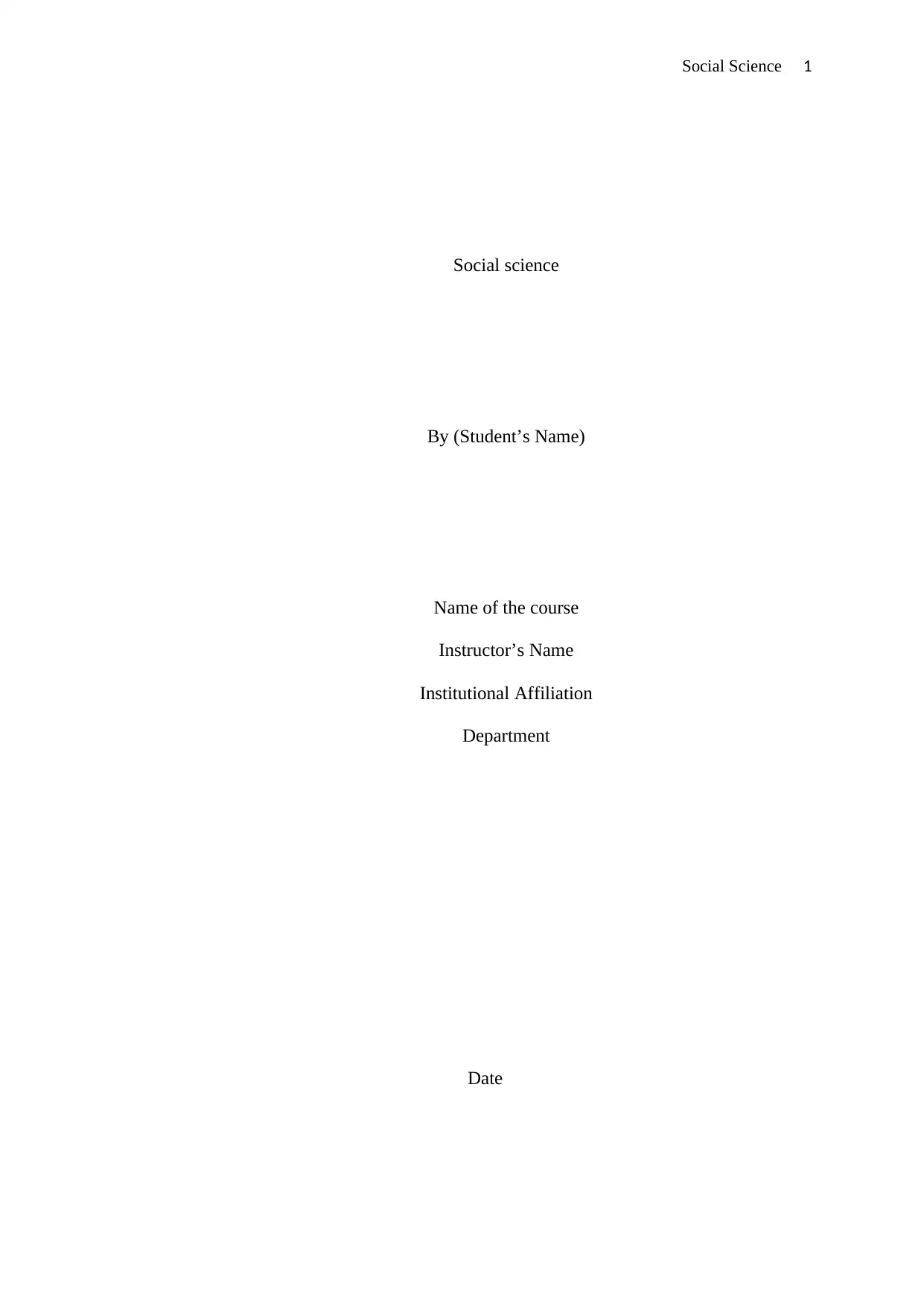
Social Science 1
Social science
By (Student’s Name)
Name of the course
Instructor’s Name
Institutional Affiliation
Department
Date
Social science
By (Student’s Name)
Name of the course
Instructor’s Name
Institutional Affiliation
Department
Date
Secure Best Marks with AI Grader
Need help grading? Try our AI Grader for instant feedback on your assignments.
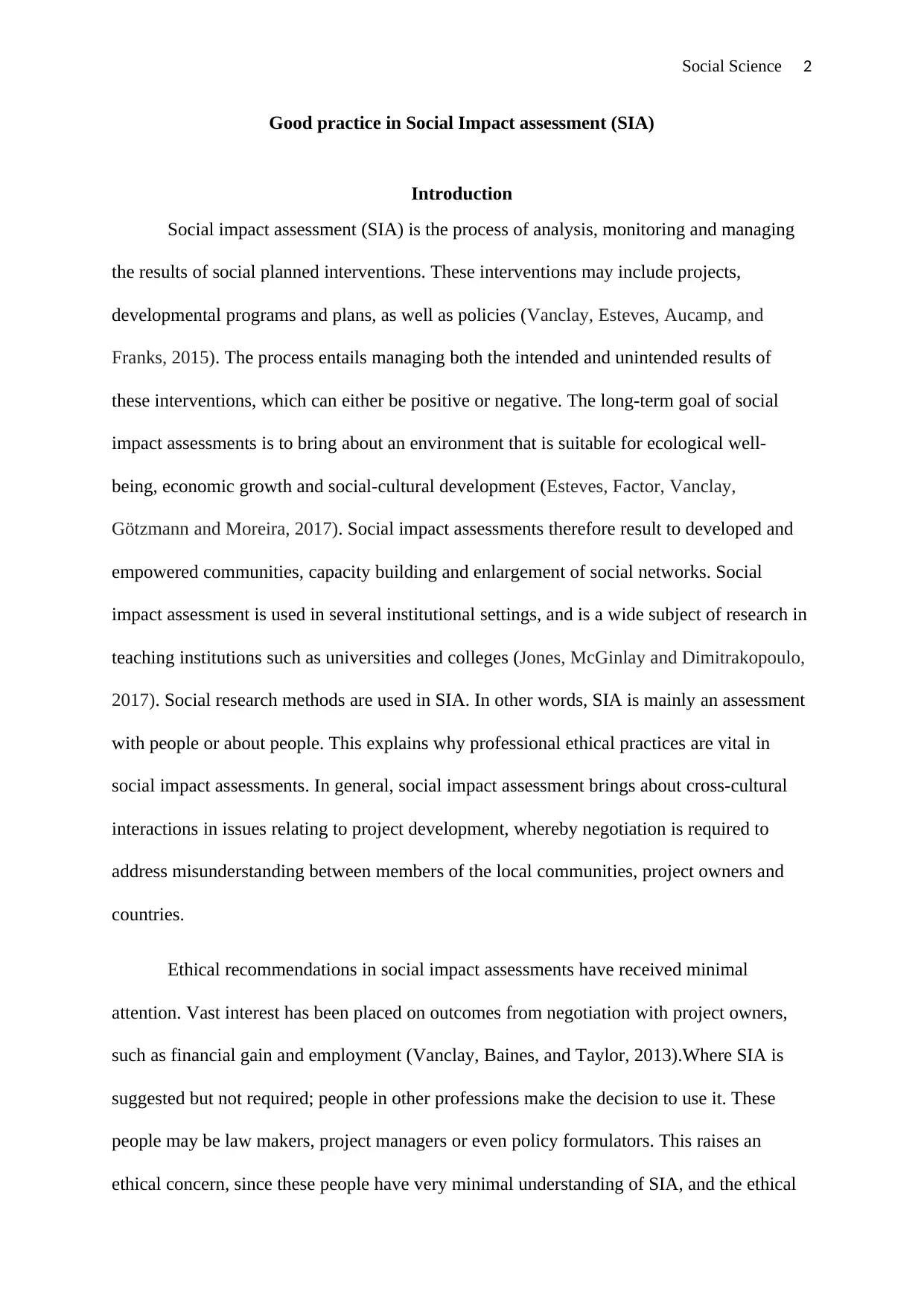
Social Science 2
Good practice in Social Impact assessment (SIA)
Introduction
Social impact assessment (SIA) is the process of analysis, monitoring and managing
the results of social planned interventions. These interventions may include projects,
developmental programs and plans, as well as policies (Vanclay, Esteves, Aucamp, and
Franks, 2015). The process entails managing both the intended and unintended results of
these interventions, which can either be positive or negative. The long-term goal of social
impact assessments is to bring about an environment that is suitable for ecological well-
being, economic growth and social-cultural development (Esteves, Factor, Vanclay,
Götzmann and Moreira, 2017). Social impact assessments therefore result to developed and
empowered communities, capacity building and enlargement of social networks. Social
impact assessment is used in several institutional settings, and is a wide subject of research in
teaching institutions such as universities and colleges (Jones, McGinlay and Dimitrakopoulo,
2017). Social research methods are used in SIA. In other words, SIA is mainly an assessment
with people or about people. This explains why professional ethical practices are vital in
social impact assessments. In general, social impact assessment brings about cross-cultural
interactions in issues relating to project development, whereby negotiation is required to
address misunderstanding between members of the local communities, project owners and
countries.
Ethical recommendations in social impact assessments have received minimal
attention. Vast interest has been placed on outcomes from negotiation with project owners,
such as financial gain and employment (Vanclay, Baines, and Taylor, 2013).Where SIA is
suggested but not required; people in other professions make the decision to use it. These
people may be law makers, project managers or even policy formulators. This raises an
ethical concern, since these people have very minimal understanding of SIA, and the ethical
Good practice in Social Impact assessment (SIA)
Introduction
Social impact assessment (SIA) is the process of analysis, monitoring and managing
the results of social planned interventions. These interventions may include projects,
developmental programs and plans, as well as policies (Vanclay, Esteves, Aucamp, and
Franks, 2015). The process entails managing both the intended and unintended results of
these interventions, which can either be positive or negative. The long-term goal of social
impact assessments is to bring about an environment that is suitable for ecological well-
being, economic growth and social-cultural development (Esteves, Factor, Vanclay,
Götzmann and Moreira, 2017). Social impact assessments therefore result to developed and
empowered communities, capacity building and enlargement of social networks. Social
impact assessment is used in several institutional settings, and is a wide subject of research in
teaching institutions such as universities and colleges (Jones, McGinlay and Dimitrakopoulo,
2017). Social research methods are used in SIA. In other words, SIA is mainly an assessment
with people or about people. This explains why professional ethical practices are vital in
social impact assessments. In general, social impact assessment brings about cross-cultural
interactions in issues relating to project development, whereby negotiation is required to
address misunderstanding between members of the local communities, project owners and
countries.
Ethical recommendations in social impact assessments have received minimal
attention. Vast interest has been placed on outcomes from negotiation with project owners,
such as financial gain and employment (Vanclay, Baines, and Taylor, 2013).Where SIA is
suggested but not required; people in other professions make the decision to use it. These
people may be law makers, project managers or even policy formulators. This raises an
ethical concern, since these people have very minimal understanding of SIA, and the ethical
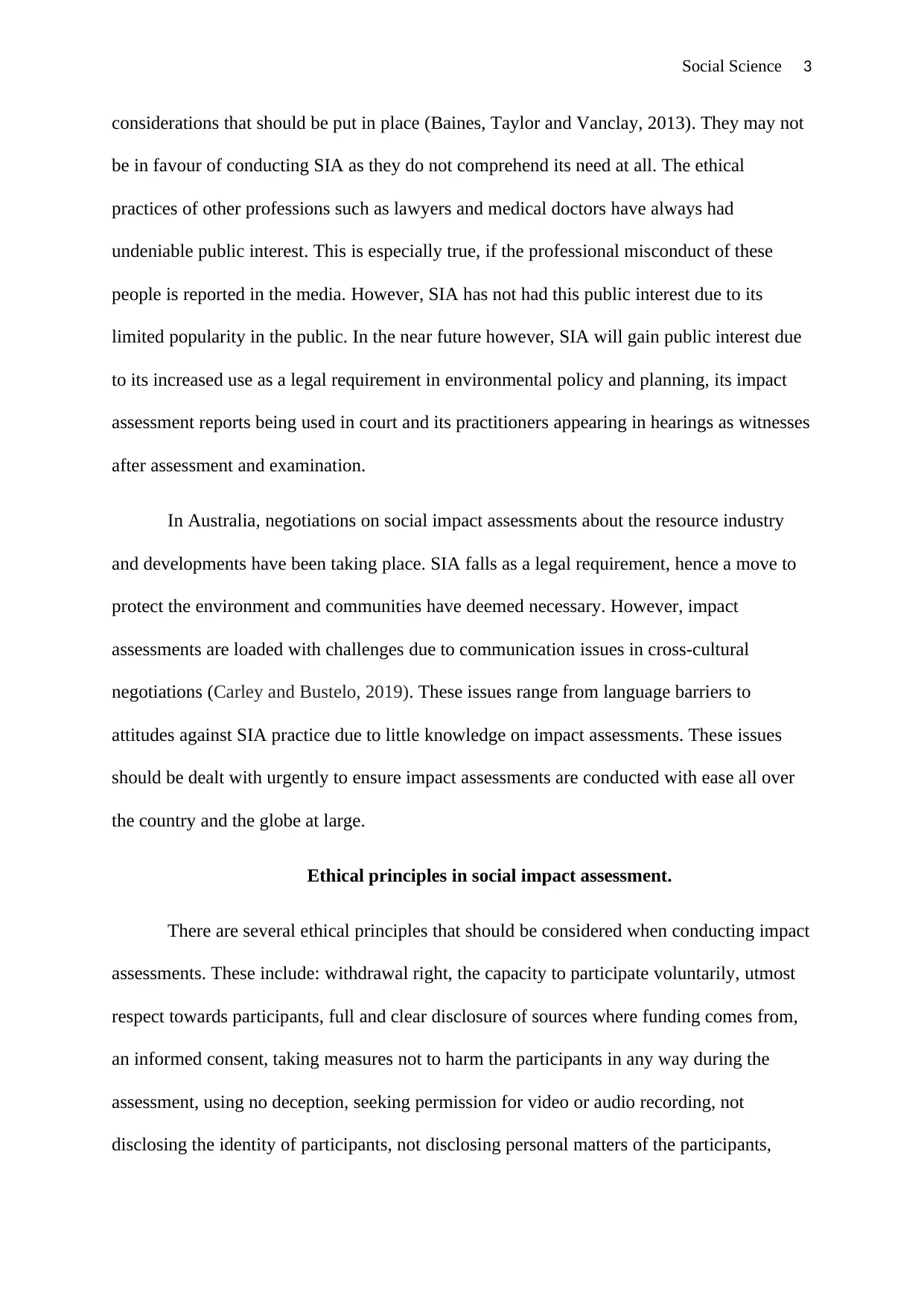
Social Science 3
considerations that should be put in place (Baines, Taylor and Vanclay, 2013). They may not
be in favour of conducting SIA as they do not comprehend its need at all. The ethical
practices of other professions such as lawyers and medical doctors have always had
undeniable public interest. This is especially true, if the professional misconduct of these
people is reported in the media. However, SIA has not had this public interest due to its
limited popularity in the public. In the near future however, SIA will gain public interest due
to its increased use as a legal requirement in environmental policy and planning, its impact
assessment reports being used in court and its practitioners appearing in hearings as witnesses
after assessment and examination.
In Australia, negotiations on social impact assessments about the resource industry
and developments have been taking place. SIA falls as a legal requirement, hence a move to
protect the environment and communities have deemed necessary. However, impact
assessments are loaded with challenges due to communication issues in cross-cultural
negotiations (Carley and Bustelo, 2019). These issues range from language barriers to
attitudes against SIA practice due to little knowledge on impact assessments. These issues
should be dealt with urgently to ensure impact assessments are conducted with ease all over
the country and the globe at large.
Ethical principles in social impact assessment.
There are several ethical principles that should be considered when conducting impact
assessments. These include: withdrawal right, the capacity to participate voluntarily, utmost
respect towards participants, full and clear disclosure of sources where funding comes from,
an informed consent, taking measures not to harm the participants in any way during the
assessment, using no deception, seeking permission for video or audio recording, not
disclosing the identity of participants, not disclosing personal matters of the participants,
considerations that should be put in place (Baines, Taylor and Vanclay, 2013). They may not
be in favour of conducting SIA as they do not comprehend its need at all. The ethical
practices of other professions such as lawyers and medical doctors have always had
undeniable public interest. This is especially true, if the professional misconduct of these
people is reported in the media. However, SIA has not had this public interest due to its
limited popularity in the public. In the near future however, SIA will gain public interest due
to its increased use as a legal requirement in environmental policy and planning, its impact
assessment reports being used in court and its practitioners appearing in hearings as witnesses
after assessment and examination.
In Australia, negotiations on social impact assessments about the resource industry
and developments have been taking place. SIA falls as a legal requirement, hence a move to
protect the environment and communities have deemed necessary. However, impact
assessments are loaded with challenges due to communication issues in cross-cultural
negotiations (Carley and Bustelo, 2019). These issues range from language barriers to
attitudes against SIA practice due to little knowledge on impact assessments. These issues
should be dealt with urgently to ensure impact assessments are conducted with ease all over
the country and the globe at large.
Ethical principles in social impact assessment.
There are several ethical principles that should be considered when conducting impact
assessments. These include: withdrawal right, the capacity to participate voluntarily, utmost
respect towards participants, full and clear disclosure of sources where funding comes from,
an informed consent, taking measures not to harm the participants in any way during the
assessment, using no deception, seeking permission for video or audio recording, not
disclosing the identity of participants, not disclosing personal matters of the participants,
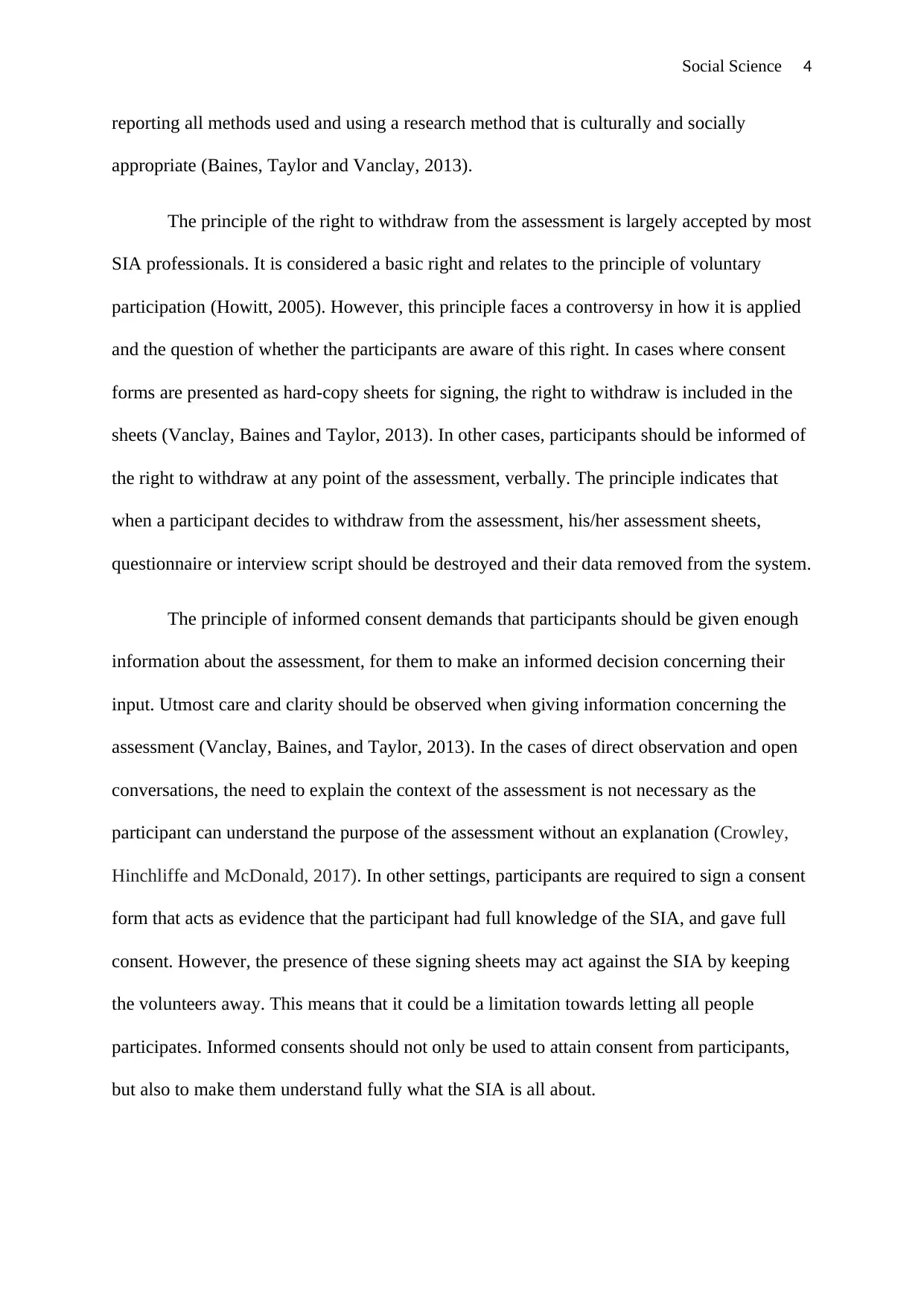
Social Science 4
reporting all methods used and using a research method that is culturally and socially
appropriate (Baines, Taylor and Vanclay, 2013).
The principle of the right to withdraw from the assessment is largely accepted by most
SIA professionals. It is considered a basic right and relates to the principle of voluntary
participation (Howitt, 2005). However, this principle faces a controversy in how it is applied
and the question of whether the participants are aware of this right. In cases where consent
forms are presented as hard-copy sheets for signing, the right to withdraw is included in the
sheets (Vanclay, Baines and Taylor, 2013). In other cases, participants should be informed of
the right to withdraw at any point of the assessment, verbally. The principle indicates that
when a participant decides to withdraw from the assessment, his/her assessment sheets,
questionnaire or interview script should be destroyed and their data removed from the system.
The principle of informed consent demands that participants should be given enough
information about the assessment, for them to make an informed decision concerning their
input. Utmost care and clarity should be observed when giving information concerning the
assessment (Vanclay, Baines, and Taylor, 2013). In the cases of direct observation and open
conversations, the need to explain the context of the assessment is not necessary as the
participant can understand the purpose of the assessment without an explanation (Crowley,
Hinchliffe and McDonald, 2017). In other settings, participants are required to sign a consent
form that acts as evidence that the participant had full knowledge of the SIA, and gave full
consent. However, the presence of these signing sheets may act against the SIA by keeping
the volunteers away. This means that it could be a limitation towards letting all people
participates. Informed consents should not only be used to attain consent from participants,
but also to make them understand fully what the SIA is all about.
reporting all methods used and using a research method that is culturally and socially
appropriate (Baines, Taylor and Vanclay, 2013).
The principle of the right to withdraw from the assessment is largely accepted by most
SIA professionals. It is considered a basic right and relates to the principle of voluntary
participation (Howitt, 2005). However, this principle faces a controversy in how it is applied
and the question of whether the participants are aware of this right. In cases where consent
forms are presented as hard-copy sheets for signing, the right to withdraw is included in the
sheets (Vanclay, Baines and Taylor, 2013). In other cases, participants should be informed of
the right to withdraw at any point of the assessment, verbally. The principle indicates that
when a participant decides to withdraw from the assessment, his/her assessment sheets,
questionnaire or interview script should be destroyed and their data removed from the system.
The principle of informed consent demands that participants should be given enough
information about the assessment, for them to make an informed decision concerning their
input. Utmost care and clarity should be observed when giving information concerning the
assessment (Vanclay, Baines, and Taylor, 2013). In the cases of direct observation and open
conversations, the need to explain the context of the assessment is not necessary as the
participant can understand the purpose of the assessment without an explanation (Crowley,
Hinchliffe and McDonald, 2017). In other settings, participants are required to sign a consent
form that acts as evidence that the participant had full knowledge of the SIA, and gave full
consent. However, the presence of these signing sheets may act against the SIA by keeping
the volunteers away. This means that it could be a limitation towards letting all people
participates. Informed consents should not only be used to attain consent from participants,
but also to make them understand fully what the SIA is all about.
Secure Best Marks with AI Grader
Need help grading? Try our AI Grader for instant feedback on your assignments.
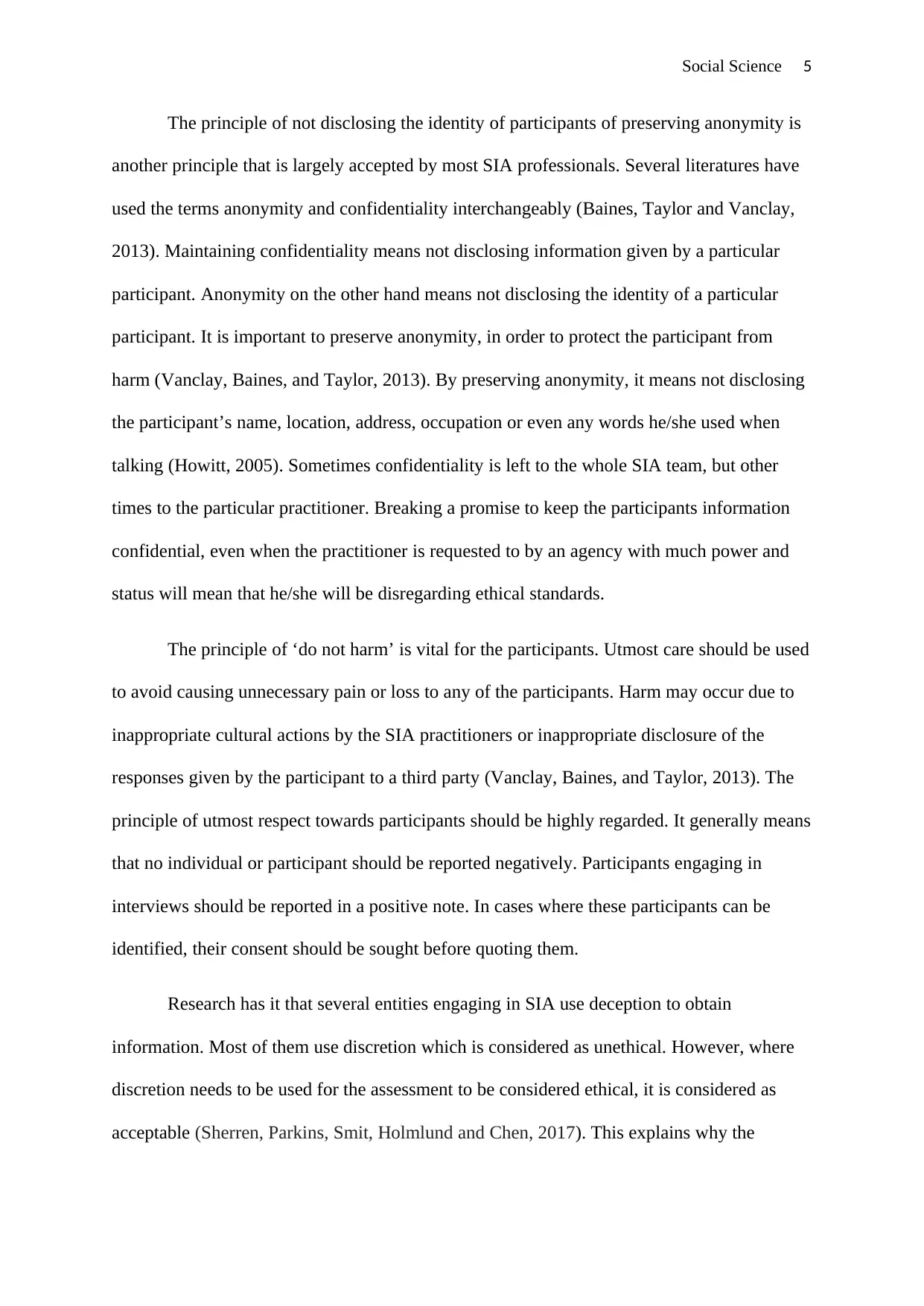
Social Science 5
The principle of not disclosing the identity of participants of preserving anonymity is
another principle that is largely accepted by most SIA professionals. Several literatures have
used the terms anonymity and confidentiality interchangeably (Baines, Taylor and Vanclay,
2013). Maintaining confidentiality means not disclosing information given by a particular
participant. Anonymity on the other hand means not disclosing the identity of a particular
participant. It is important to preserve anonymity, in order to protect the participant from
harm (Vanclay, Baines, and Taylor, 2013). By preserving anonymity, it means not disclosing
the participant’s name, location, address, occupation or even any words he/she used when
talking (Howitt, 2005). Sometimes confidentiality is left to the whole SIA team, but other
times to the particular practitioner. Breaking a promise to keep the participants information
confidential, even when the practitioner is requested to by an agency with much power and
status will mean that he/she will be disregarding ethical standards.
The principle of ‘do not harm’ is vital for the participants. Utmost care should be used
to avoid causing unnecessary pain or loss to any of the participants. Harm may occur due to
inappropriate cultural actions by the SIA practitioners or inappropriate disclosure of the
responses given by the participant to a third party (Vanclay, Baines, and Taylor, 2013). The
principle of utmost respect towards participants should be highly regarded. It generally means
that no individual or participant should be reported negatively. Participants engaging in
interviews should be reported in a positive note. In cases where these participants can be
identified, their consent should be sought before quoting them.
Research has it that several entities engaging in SIA use deception to obtain
information. Most of them use discretion which is considered as unethical. However, where
discretion needs to be used for the assessment to be considered ethical, it is considered as
acceptable (Sherren, Parkins, Smit, Holmlund and Chen, 2017). This explains why the
The principle of not disclosing the identity of participants of preserving anonymity is
another principle that is largely accepted by most SIA professionals. Several literatures have
used the terms anonymity and confidentiality interchangeably (Baines, Taylor and Vanclay,
2013). Maintaining confidentiality means not disclosing information given by a particular
participant. Anonymity on the other hand means not disclosing the identity of a particular
participant. It is important to preserve anonymity, in order to protect the participant from
harm (Vanclay, Baines, and Taylor, 2013). By preserving anonymity, it means not disclosing
the participant’s name, location, address, occupation or even any words he/she used when
talking (Howitt, 2005). Sometimes confidentiality is left to the whole SIA team, but other
times to the particular practitioner. Breaking a promise to keep the participants information
confidential, even when the practitioner is requested to by an agency with much power and
status will mean that he/she will be disregarding ethical standards.
The principle of ‘do not harm’ is vital for the participants. Utmost care should be used
to avoid causing unnecessary pain or loss to any of the participants. Harm may occur due to
inappropriate cultural actions by the SIA practitioners or inappropriate disclosure of the
responses given by the participant to a third party (Vanclay, Baines, and Taylor, 2013). The
principle of utmost respect towards participants should be highly regarded. It generally means
that no individual or participant should be reported negatively. Participants engaging in
interviews should be reported in a positive note. In cases where these participants can be
identified, their consent should be sought before quoting them.
Research has it that several entities engaging in SIA use deception to obtain
information. Most of them use discretion which is considered as unethical. However, where
discretion needs to be used for the assessment to be considered ethical, it is considered as
acceptable (Sherren, Parkins, Smit, Holmlund and Chen, 2017). This explains why the
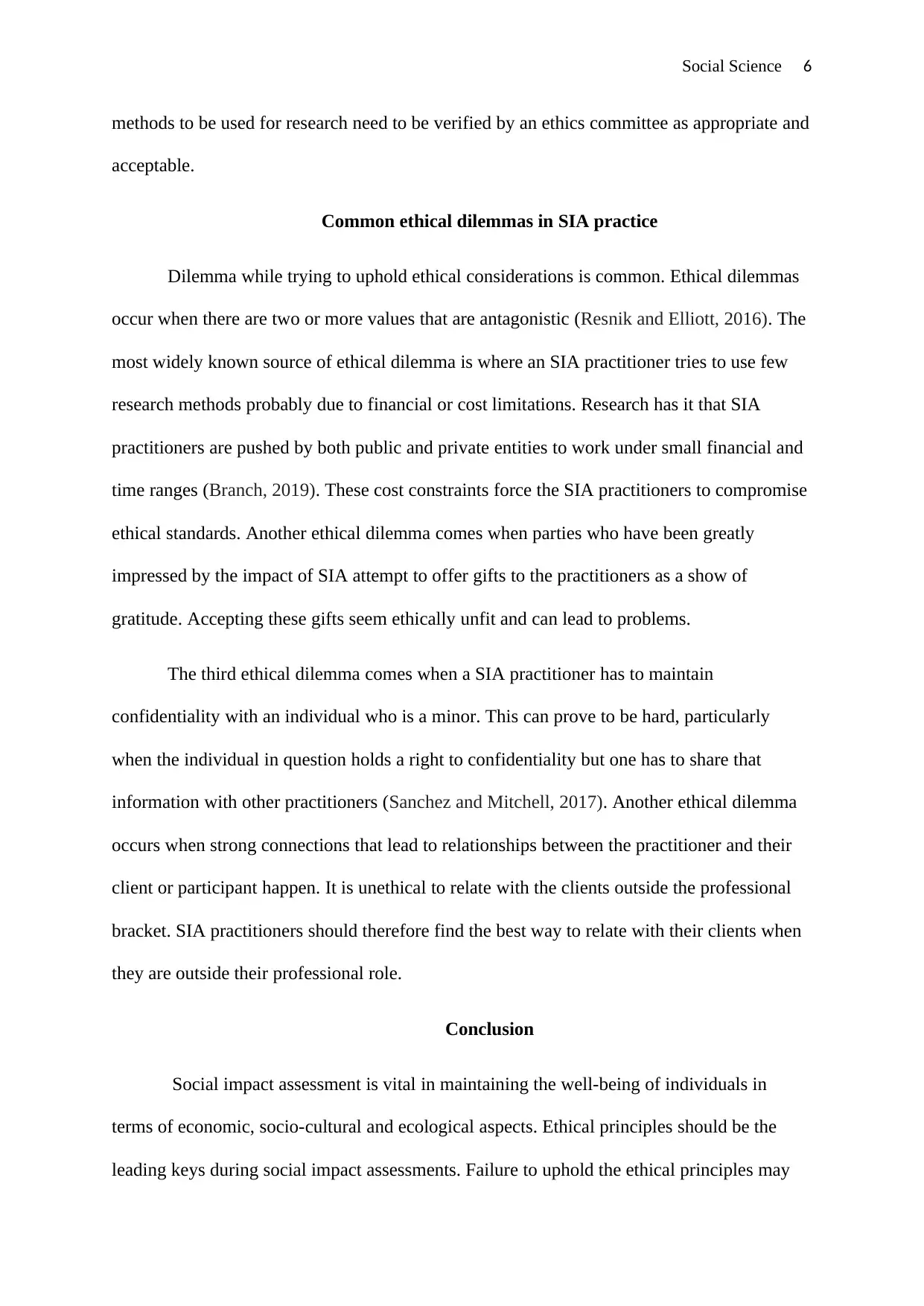
Social Science 6
methods to be used for research need to be verified by an ethics committee as appropriate and
acceptable.
Common ethical dilemmas in SIA practice
Dilemma while trying to uphold ethical considerations is common. Ethical dilemmas
occur when there are two or more values that are antagonistic (Resnik and Elliott, 2016). The
most widely known source of ethical dilemma is where an SIA practitioner tries to use few
research methods probably due to financial or cost limitations. Research has it that SIA
practitioners are pushed by both public and private entities to work under small financial and
time ranges (Branch, 2019). These cost constraints force the SIA practitioners to compromise
ethical standards. Another ethical dilemma comes when parties who have been greatly
impressed by the impact of SIA attempt to offer gifts to the practitioners as a show of
gratitude. Accepting these gifts seem ethically unfit and can lead to problems.
The third ethical dilemma comes when a SIA practitioner has to maintain
confidentiality with an individual who is a minor. This can prove to be hard, particularly
when the individual in question holds a right to confidentiality but one has to share that
information with other practitioners (Sanchez and Mitchell, 2017). Another ethical dilemma
occurs when strong connections that lead to relationships between the practitioner and their
client or participant happen. It is unethical to relate with the clients outside the professional
bracket. SIA practitioners should therefore find the best way to relate with their clients when
they are outside their professional role.
Conclusion
Social impact assessment is vital in maintaining the well-being of individuals in
terms of economic, socio-cultural and ecological aspects. Ethical principles should be the
leading keys during social impact assessments. Failure to uphold the ethical principles may
methods to be used for research need to be verified by an ethics committee as appropriate and
acceptable.
Common ethical dilemmas in SIA practice
Dilemma while trying to uphold ethical considerations is common. Ethical dilemmas
occur when there are two or more values that are antagonistic (Resnik and Elliott, 2016). The
most widely known source of ethical dilemma is where an SIA practitioner tries to use few
research methods probably due to financial or cost limitations. Research has it that SIA
practitioners are pushed by both public and private entities to work under small financial and
time ranges (Branch, 2019). These cost constraints force the SIA practitioners to compromise
ethical standards. Another ethical dilemma comes when parties who have been greatly
impressed by the impact of SIA attempt to offer gifts to the practitioners as a show of
gratitude. Accepting these gifts seem ethically unfit and can lead to problems.
The third ethical dilemma comes when a SIA practitioner has to maintain
confidentiality with an individual who is a minor. This can prove to be hard, particularly
when the individual in question holds a right to confidentiality but one has to share that
information with other practitioners (Sanchez and Mitchell, 2017). Another ethical dilemma
occurs when strong connections that lead to relationships between the practitioner and their
client or participant happen. It is unethical to relate with the clients outside the professional
bracket. SIA practitioners should therefore find the best way to relate with their clients when
they are outside their professional role.
Conclusion
Social impact assessment is vital in maintaining the well-being of individuals in
terms of economic, socio-cultural and ecological aspects. Ethical principles should be the
leading keys during social impact assessments. Failure to uphold the ethical principles may

Social Science 7
lead to tough measures against the SIA practitioners by the responsible regulatory bodies.
The SIA practitioners should at all times uphold ethical integrity despite the dilemmas that
occur in the line of work.
lead to tough measures against the SIA practitioners by the responsible regulatory bodies.
The SIA practitioners should at all times uphold ethical integrity despite the dilemmas that
occur in the line of work.
Paraphrase This Document
Need a fresh take? Get an instant paraphrase of this document with our AI Paraphraser
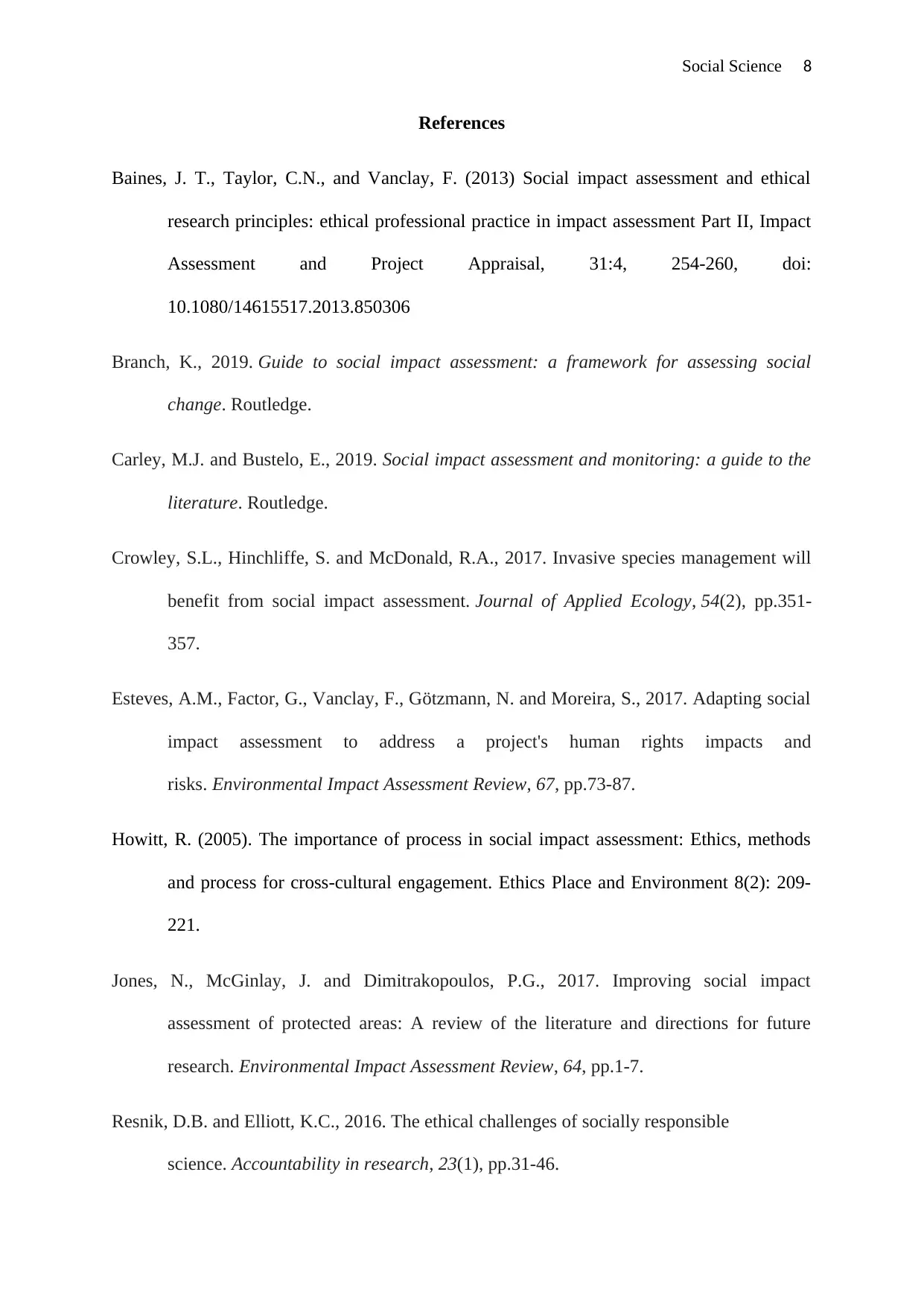
Social Science 8
References
Baines, J. T., Taylor, C.N., and Vanclay, F. (2013) Social impact assessment and ethical
research principles: ethical professional practice in impact assessment Part II, Impact
Assessment and Project Appraisal, 31:4, 254-260, doi:
10.1080/14615517.2013.850306
Branch, K., 2019. Guide to social impact assessment: a framework for assessing social
change. Routledge.
Carley, M.J. and Bustelo, E., 2019. Social impact assessment and monitoring: a guide to the
literature. Routledge.
Crowley, S.L., Hinchliffe, S. and McDonald, R.A., 2017. Invasive species management will
benefit from social impact assessment. Journal of Applied Ecology, 54(2), pp.351-
357.
Esteves, A.M., Factor, G., Vanclay, F., Götzmann, N. and Moreira, S., 2017. Adapting social
impact assessment to address a project's human rights impacts and
risks. Environmental Impact Assessment Review, 67, pp.73-87.
Howitt, R. (2005). The importance of process in social impact assessment: Ethics, methods
and process for cross-cultural engagement. Ethics Place and Environment 8(2): 209-
221.
Jones, N., McGinlay, J. and Dimitrakopoulos, P.G., 2017. Improving social impact
assessment of protected areas: A review of the literature and directions for future
research. Environmental Impact Assessment Review, 64, pp.1-7.
Resnik, D.B. and Elliott, K.C., 2016. The ethical challenges of socially responsible
science. Accountability in research, 23(1), pp.31-46.
References
Baines, J. T., Taylor, C.N., and Vanclay, F. (2013) Social impact assessment and ethical
research principles: ethical professional practice in impact assessment Part II, Impact
Assessment and Project Appraisal, 31:4, 254-260, doi:
10.1080/14615517.2013.850306
Branch, K., 2019. Guide to social impact assessment: a framework for assessing social
change. Routledge.
Carley, M.J. and Bustelo, E., 2019. Social impact assessment and monitoring: a guide to the
literature. Routledge.
Crowley, S.L., Hinchliffe, S. and McDonald, R.A., 2017. Invasive species management will
benefit from social impact assessment. Journal of Applied Ecology, 54(2), pp.351-
357.
Esteves, A.M., Factor, G., Vanclay, F., Götzmann, N. and Moreira, S., 2017. Adapting social
impact assessment to address a project's human rights impacts and
risks. Environmental Impact Assessment Review, 67, pp.73-87.
Howitt, R. (2005). The importance of process in social impact assessment: Ethics, methods
and process for cross-cultural engagement. Ethics Place and Environment 8(2): 209-
221.
Jones, N., McGinlay, J. and Dimitrakopoulos, P.G., 2017. Improving social impact
assessment of protected areas: A review of the literature and directions for future
research. Environmental Impact Assessment Review, 64, pp.1-7.
Resnik, D.B. and Elliott, K.C., 2016. The ethical challenges of socially responsible
science. Accountability in research, 23(1), pp.31-46.
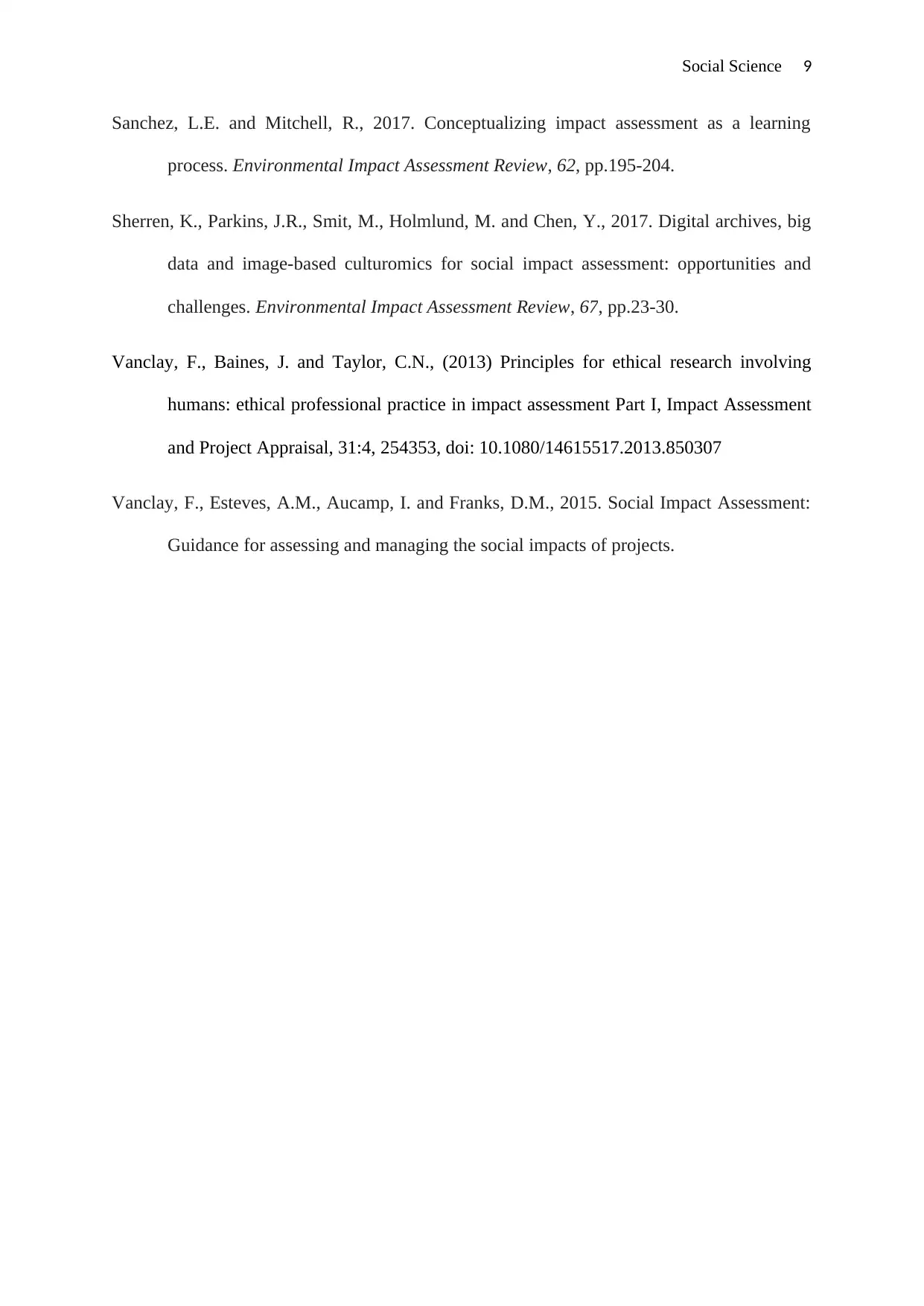
Social Science 9
Sanchez, L.E. and Mitchell, R., 2017. Conceptualizing impact assessment as a learning
process. Environmental Impact Assessment Review, 62, pp.195-204.
Sherren, K., Parkins, J.R., Smit, M., Holmlund, M. and Chen, Y., 2017. Digital archives, big
data and image-based culturomics for social impact assessment: opportunities and
challenges. Environmental Impact Assessment Review, 67, pp.23-30.
Vanclay, F., Baines, J. and Taylor, C.N., (2013) Principles for ethical research involving
humans: ethical professional practice in impact assessment Part I, Impact Assessment
and Project Appraisal, 31:4, 254353, doi: 10.1080/14615517.2013.850307
Vanclay, F., Esteves, A.M., Aucamp, I. and Franks, D.M., 2015. Social Impact Assessment:
Guidance for assessing and managing the social impacts of projects.
Sanchez, L.E. and Mitchell, R., 2017. Conceptualizing impact assessment as a learning
process. Environmental Impact Assessment Review, 62, pp.195-204.
Sherren, K., Parkins, J.R., Smit, M., Holmlund, M. and Chen, Y., 2017. Digital archives, big
data and image-based culturomics for social impact assessment: opportunities and
challenges. Environmental Impact Assessment Review, 67, pp.23-30.
Vanclay, F., Baines, J. and Taylor, C.N., (2013) Principles for ethical research involving
humans: ethical professional practice in impact assessment Part I, Impact Assessment
and Project Appraisal, 31:4, 254353, doi: 10.1080/14615517.2013.850307
Vanclay, F., Esteves, A.M., Aucamp, I. and Franks, D.M., 2015. Social Impact Assessment:
Guidance for assessing and managing the social impacts of projects.
1 out of 9
Related Documents
Your All-in-One AI-Powered Toolkit for Academic Success.
+13062052269
info@desklib.com
Available 24*7 on WhatsApp / Email
![[object Object]](/_next/static/media/star-bottom.7253800d.svg)
Unlock your academic potential
© 2024 | Zucol Services PVT LTD | All rights reserved.





